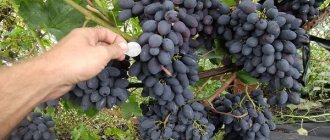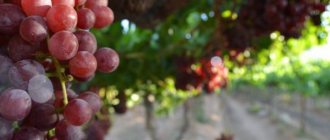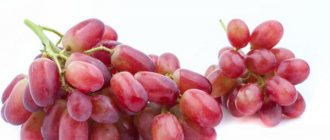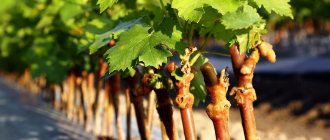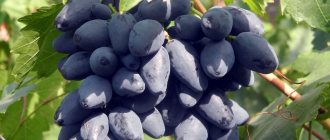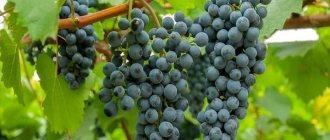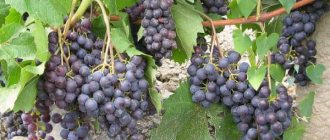Description
Buffalo Grapes (Herbert x Watkins) – (Herbert x Watkins).
Developed at the New York State Agricultural Experiment Station. Cornell University in the USA. Buffalo is a universal grape variety, bred in 1938.
Early-mid ripening - in the south of Ukraine (Odessa), full maturity of the berries occurs in the first ten days of September.
The growth vigor of the bushes is good, the shoots ripen by 90% of the total growth.
The leaves are large, beautiful, light green, almost entire, wedge-shaped. The flower is bisexual.
The clusters are medium-sized, loose, conical.
The berry is black, slightly oval, medium size.
The taste is original strawberry.
Sugar accumulation is from 18 to 21%, with acidity from 5.4 to 9.9 g/l.
Productivity 100-120 c/ha.
Conditions: relatively high winter hardiness, resistance to mildew and gray rot of berries.
Application: with good care, the bushes grow vigorously and cover balconies, house walls, and terraces well. Grapes can be consumed fresh, as well as for making aromatic juice and wine.
Order Buffalo Grapes from our garden center. More than 3,000 different plants and seedlings for every taste. Order by phone: 7 or come to our garden center.
Our address:
Moscow region, Ramensky district, Donino village, st. Central, school. 189a
Telephone:
7
E-mail: [email protected] Opening hours:
daily from Monday to Friday from 9.00 to 21.00, on Saturday from 8.00 to 21.00, on Sunday from 11.00 to 17.00
What type does it belong to?
Buffalo is a universal table variety of American selection, ripening period is early-medium.
It is characterized by winter hardiness and high yield. Full ripening occurs in the first half of September. Varieties such as Alpha, Witch's Fingers and Cardinal also come from America.
https://www.youtube.com/watch?v=ytcreatorsru
The level of sugar accumulation at an acidity level of 5.5-9.9 g/l can reach 21%. It crosses well with other varieties, especially with European ones - the resulting offspring have the best features of the parent varieties.
Fruiting vines are pruned to eight to nine buds.
The grapes are propagated by cuttings, which are taken in the fall from a good, high-yielding variety. For this purpose, mature annual shoots with a diameter of up to 1.5 cm are suitable. Prepared cuttings are collected in bunches and packaged in polyethylene. They should be stored in a cold room (basement), where the temperature does not rise above 5 degrees.
Cuttings and planting, description of care
Unfortunately, Vulture grape cuttings have worse rooting rates compared to other varieties. Carefully choose a supply for grafting Vulture. Vigorous bushes will not allow the grapes to take root. Rooted plants will begin to produce fruits after 4 years.
Like every grape, the Vulture variety loves abundantly sunlit areas.
Therefore, when planting grape seedlings, you should take this feature into account and do not place the bush in the shade of tall trees or buildings. The choice of soil when planting a plant determines how easily your grapes can receive nutrients. Once every 2-3 years, fertilizers should be added to the soil near the plant. This will prevent depletion and replenish nutrients and minerals.
Do not plant grape bushes close to each other. This will not allow any of the bushes to develop fully. Their rhizomes, competing for water and nutrients, can become intertwined. As a result, one grape bush will draw all the life-giving substances from the soil of another.
There are known cases of berries burning out in the sun. This is due to the fact that the dark pigment contained in the berry can fade when exposed to sunlight. You should not be afraid that this phenomenon will somehow negatively affect the taste of the grapes.
On the contrary, grapes that receive more light will have a sweeter taste.
Despite the good resistance of the variety to diseases, you should still pay attention to the color of the leaves and the condition of the bunches. We should not forget that foliage that tightly covers the clusters from sunlight should be thinned out or removed altogether.
As soon as you notice formations uncharacteristic of grapes on any part of the bush, you should take measures to prevent diseases. If mold, rot or other manifestations of pathogenic influence are clearly visible, you should contact an experienced gardener to determine the disease that has affected the bush. Delaying the time for treatment is extremely dangerous.
The disease can affect not only one bush, but the entire vineyard, destroying the harvest for that year, and sometimes the entire plant.
The Vulture grape variety is an excellent fruit-bearing, tasty and unpretentious variety. Compliance with all the rules of plant care and planting will provide you with a rich and stable harvest for many years.
Buffalo grapes - variety description
- VINE "
- Grape varieties and GF »
- Grape varieties »
- grape varieties on B (Moderators: Tatyana Kitayeva, Sergey 54, Leonty Yarygin, dayton) »
- Buffalo - technical grape variety
0 Users and 1 Guest are viewing this topic.
- VINE "
- Grape varieties and GF »
- Grape varieties »
- grape varieties on B (Moderators: Tatyana Kitayeva, Sergey 54, Leonty Yarygin, dayton) »
- Buffalo - technical grape variety
We invite you to familiarize yourself with Cheremsha: where it grows in Russia and in what area
White, dark, pink
- A popular white grape variety for the Moscow region is Stremennoy. The bushes are medium-sized, the leaves have bristly pubescence. The berries are small, oval, white. The purpose is universal, the crop does not crack during transportation. The clusters are medium conical. The taste of the berries is harmonious, the flesh is gristly. Another common white grape variety is Chrysolite. The weight of the bunch is 600 g, the berries are medium white-yellow.
- Podarok Nesvetaya grapes are distinguished from dark varieties. The bushes are vigorous, the flowers are bisexual. The berries are round-oval and dark purple. The pulp is fleshy, the taste is nutmeg. The juice is pink, the skin is strong. The weight of the bunch is 700 g, the weight of the fruit is about 5 g. The Pamyat Dombkovskaya variety is popular - the berries are round, weigh about 4 g, and are black in color. The clusters are cylindrical-conical and weigh about 370 g.
- The pink variety Transfiguration is valued for its immunity and rapid growth of shoots. The berries are large, cylindrical, weigh 10-11 g. The color is pink, the flesh is juicy, with a nutmeg aftertaste. The juice is colorless. The crop is used for processing and fresh consumption. Another famous variety is Jubilee of Novocherkassk. The clusters are large, weighing 1000–1500 g. The pulp is fleshy, there is no aftertaste, the juice is colorless.
Diseases and pests
Despite the fact that Buffalo is too tough for powdery mildew, oidium, mildew and many other fungi, it is still necessary to take care of it. Especially if you want the precious vine to live and bear fruit for many years.
For the best result, it is worth knowing the enemy by sight. Read about what anthracnose, chlorosis, bacteriosis, bacterial cancer, rubella are in separate articles on our website.
If a summer resident neglects the condition of his bush, then there is nothing to be surprised that it will not last long, and there is no point in talking about fruiting.
Buffalo may not be afraid of fungi, but it has other enemies - wasps, ticks, bees, birds, leaf rollers, beetles. Parasites gnaw young shoots, eat out grape buds and eyes, spoil the berries, destroy the leaves. Don’t despair - you can find control on them.
Ticks. They are afraid of spraying with sulfur-containing preparations, also DNOC, phosphamine, neoron.
Leaf rollers do not tolerate insecticides. In addition, the bark should be cleaned from pupae in a timely manner (“cleanings must be burned”) and plant debris should be removed. You need to make sure that the bush is well ventilated.
Wasps. They will be stopped by special smoke bombs and jam traps. A simple remedy will also help - a “balaclava” made from an old nylon stocking, placed on top of the bush. This way you can be sure that striped predators will not get to the grapes. It is also necessary to find and burn wasp nests.
Birds. The best “barrier” would be a mesh with small cells. A bird, encountering one, flies away.
It is not recommended to resort to the “old-fashioned method”, that is, using a fishing net - few people like to release birds that are desperately screaming and saying goodbye (or even saying goodbye) to their lives..
Grapes will please your eyes and bring a bountiful harvest every year if you properly care for them and protect them from their main enemies - birds, wasps and various types of moths that love to profit from berries or shoots.
Dear visitors! Leave your feedback on the Buffalo grape variety in the comments below.
Buffalo grapes variety description photo reviews
Homemade wine, juices, fresh grapes...Who among us doesn't love this? American uncovered isabella grape varieties will help make this dream come true.
They are unpretentious, do not require special care, and cross well with more “high-born” ones. This includes the Buffalo grape variety.
What type does it belong to?
Buffalo is a universal table variety of American selection, ripening period is early-medium. It is characterized by winter hardiness and high yield. Full ripening occurs in the first half of September.
Varieties such as Alpha, Witch's Fingers and Cardinal also come from America.
The level of sugar accumulation at an acidity level of 5.5-9.9 g/l can reach 21%. It crosses well with other varieties, especially with European ones - the resulting offspring have the best features of the parent varieties.
Fruiting vines are pruned to eight to nine buds.
The grapes are propagated by cuttings, which are taken in the fall from a good, high-yielding variety. For this purpose, mature annual shoots with a diameter of up to 1.5 cm are suitable. Prepared cuttings are collected in bunches and packaged in polyethylene. They should be stored in a cold room (basement), where the temperature does not rise above 5 degrees.
History of selection and region of breeding
Obtained in the USA, at the New York State Agricultural Experiment Station of Cornell University, in 1938, by crossing the Herbert and Watkins varieties. On the territory of the former Union, it feels best in the southern regions - Ukraine, Crimea, Moldova.
Buffalo grapes: variety description
The “calling card” of this variety is the vine - bright, rich brown in color.
The berries are small (up to 50 g), oval-shaped, black, with a bright, rich taste and a strawberry aftertaste.
The flowers are bisexual. Moldova, Black Crow and Chameleon also have bisexual flowers.
The bunch is loose, cone-shaped and small in size.
The leaves are large, light green, almost entire, and wedge-shaped.
Characteristics:
The bush is vigorous, very productive (with arched formations you can sometimes collect up to 100 kg of berries from a bush), it is entwined around terraces and columns on houses.
It is characterized by high frost resistance (can withstand minus temperatures of 28-30 Celsius), and is not afraid of powdery mildew and gray rot. Good for consumption in its “natural” form, but can be used for making wine, jam, juices, etc. It belongs to the so-called non-covering varieties, that is, there is no need to “wrap up” the bush for the winter.
Among the frost-resistant varieties, Super Extra, Beauty of the North and Pink Flamingo stand out.
Photo of Buffalo grapes:
Diseases and pests
Despite the fact that Buffalo is too tough for powdery mildew, oidium, mildew and many other fungi, it is still necessary to take care of it. Especially if you want the precious vine to live and bear fruit for many years.
For the best result, it is worth knowing the enemy by sight. Read about what anthracnose, chlorosis, bacteriosis, bacterial cancer, rubella are in separate articles on our website.
Buffalo may not be afraid of fungi, but it has other enemies - wasps, ticks, bees, birds, leaf rollers, beetles. Parasites gnaw young shoots, eat out grape buds and eyes, spoil the berries, destroy the leaves... Don’t despair - you can find control on them.
Ticks. They are afraid of spraying with sulfur-containing preparations, also DNOC, phosphamine, neoron.
Leaf rollers do not tolerate insecticides. In addition, the bark should be cleaned from pupae in a timely manner (“cleanings must be burned”) and plant debris should be removed. You need to make sure that the bush is well ventilated.
Wasps. They will be stopped by special smoke bombs and jam traps. A simple remedy will also help - a “balaclava” made from an old nylon stocking, placed on top of the bush. This way you can be sure that striped predators will not get to the grapes. It is also necessary to find and burn wasp nests.
Birds. The best “barrier” would be a mesh with small cells. A bird, encountering one, flies away.
Grapes will please your eyes and bring a bountiful harvest every year if you properly care for them and protect them from their main enemies - birds, wasps and various types of moths that love to profit from berries or shoots.
If you find an error, please select a piece of text and press Ctrl+Enter.
Viticulture is the most effective branch of the state’s agro-industrial complex, as well as an integral part of every gardener’s cultivation of popular berries.
A unique climbing shrub plant with large sweet black berries is a grape that has gained high popularity among gardeners for its high yield and ease of care, and is called buffalo.
The breeding of this variety was made possible through artificial selection, crossing with other plant species of a similar species: Herbert and Watkins. Thanks to the efforts of agronomist breeders from New York Cornell University, the selection of this variety was carried out in the late 30s of the twentieth century. The plant received its name in honor of a city located in the northwestern part of New York state.
Description of the variety
The plant belongs to the table variety Isabella. Buffalo has excellent bush vigor with large, light green leaves. The grape bunches reach a medium size, the berries are densely arranged and resemble a conical shape. The shoots ripen with a high growth rate, more than 90%, which ensures high productivity, and at the end the gardener will receive a large round berry with an original taste, which is suitable both for food and for making wine, juice, jam, and all kinds of potions.
Ripening occurs in mid-September, which makes it possible to classify it as an early-mid ripening period, however, despite the rapid ripening, the grapes have relatively high frost resistance, down to approximately minus 25-30 degrees. The plant is also resistant to fungal diseases, the most dangerous of which are powdery mildew, which affects the leaves, as well as a cosmopolitan fungus, which has a detrimental effect on the berries, expressed as gray rot.
It has a high level of sugar accumulation with low acidity, which allows it to be used in the preparation of various wine drinks with minimal use of sugar, which ultimately leads to a good product at low cost and classifies it as a valuable food product and the main raw material for winemaking.
Buffalo is unpretentious in care, does not require special measures to maintain growth and ripening, and crosses well with other grape varieties, even more noble ones, and is especially often crossed with various European species.
It is necessary to prune fruit-bearing vines by nine buds; this ensures good shoot growth, which leads to dense bunch setting and increased yield.
Due to its frost resistance, these grapes are classified as non-covering varieties, that is, they do not require insulation of the bushes for the winter.
Reproduction
Grapes are propagated using cuttings, which are prepared in the autumn from a healthy, high-yielding plant, while the shoots are taken from a mature annual variety, the diameter of each cutting should be 15 mm. The cuttings are stored in a cold room with a constant temperature not exceeding 5 degrees, in plastic packaging, collected in bunches.
Diseases and pests
To ensure long-term fruiting of the plant vine, its healthy appearance and condition, despite resistance to various types of fungal diseases, care to prevent diseases, as well as timely treatment, is still necessary.
The main enemies of grapes are codling moths, leaf rollers, leaf miners, wasps, beetles, mites and even birds.
Parasites destroy young shoots, gnaw out grape buds and eyes, and have a detrimental effect on the leaves and fruits of the plant.
Delayed pest control can lead to the complete destruction of not only the crop, but the entire bush.
Pest Control
To protect the bush and berries of this variety from pests, the following measures will help:
- spraying the bush with preparations with a high sulfur content, the potent pesticide DNOC, the chemical phosphamide, neoron, which are used in viticulture as substances of contact and systemic action, will help against mites;
- From the family of butterflies and leaf roller caterpillars, poisonous chemical pest control agents called insecticides are used. Prevention that will protect the grapes is the timely cleansing of the bush bark from pupae and the removal of their remains. Providing good ventilation of the bush will help prevent the formation of pupae;
- Smoke bombs, “sweet” traps made from jam, and a balaclava stretched over a bush made of nylon material will help against the effects of wasps. Prevention will include timely detection and destruction of the wasp habitat (nest);
- a fine mesh will help keep birds away, protecting the crop from their influence, since, having stumbled upon such a fence, the birds immediately fly away. The use of a fishing net is not recommended because it tends to permanently entangle the birds.
The grapes will delight their owner and produce a high harvest every year, if they are properly and consistently cared for, as well as protected from diseases and insect pests, and the unpretentiousness of the variety allows it to become the favorite plant of every gardener!
Available options
- Product code: Buffalo grapes —>
(Herbert x Watkins) - (Herbert x Watkins) [New York State Agricultural Experimental Station, Cornell University, USA] Buffalo is a versatile grape variety, bred in 1938. Early-mid ripening, in the south of Ukraine (Odessa) the berries reach full maturity in the first ten days of September. The growth vigor of the bushes is good, the shoots ripen by 90% of the total growth. The leaves are large, beautiful, light green, almost entire, wedge-shaped. The flower is bisexual. The clusters are medium-sized, loose, conical. The berry is black, slightly oval, medium size. Has an original strawberry taste. Sugar accumulation is from 18 to 21%, with acidity from 5.4 to 9.9 g/l. Productivity 100-120 c/ha. The Buffalo grape variety is characterized by relatively high winter hardiness, resistance to mildew and gray rot of berries. With good care, the bushes grow vigorously and cover balconies, house walls, and terraces well. Grapes can be consumed fresh, as well as for making aromatic juice and wine.
Buffalo grape variety
Homemade wine, juices, fresh grapes Who among us doesn’t love this? American uncovered isabella grape varieties will help make this dream come true.
They are unpretentious, do not require special care, and cross well with more “high-born” ones. This includes the Buffalo grape variety.
- What type does it belong to?
- History of selection and region of breeding
- Buffalo grapes: variety description
- Photo
- Diseases and pests
Care
Buffalo is unpretentious in care, does not require special measures to maintain growth and ripening, and crosses well with other grape varieties, even more noble ones, and is especially often crossed with various European species.
It is necessary to prune fruit-bearing vines by nine buds; this ensures good shoot growth, which leads to dense bunch setting and increased yield.
Due to its frost resistance, these grapes are classified as non-covering varieties, that is, they do not require insulation of the bushes for the winter.
Vulture - a variety of frost-resistant grapes
/ Grape varieties / Table grapes
Winter-hardy grape varieties are often recommended for growing by beginning winegrowers. This is explained by the fact that such varieties are less demanding and require less care. Modern breeding has made many winter-hardy varieties resistant to disease and rot.
Vulture grapes are used both for landscaping areas and for harvesting large, tasty harvests. This table grape has very large and tasty berries.
Therefore, it is suitable both for fresh consumption and for making juices, wine and compotes.
We invite you to familiarize yourself with Stone Flower (photo) - secrets, tips, recommendations
The Vulture grape variety, like many winter-hardy varieties, has a tendency to bear excessive fruit.
A beginner in the grape business sees this as a positive property. Unfortunately, if you care for the bush inexperienced, especially if the number of bunches has not been reduced, the harvest may not be as high quality as stated in the characteristics of the variety. Don't despair if your first harvest doesn't turn out as expected. By following simple recommendations, even a novice winegrower can grow an excellent bush with strong vines and large berries.
Did you know that 109 grape varieties are zoned in Ukraine? Of course, it is impossible to grow such a number of varieties on five or six dacha acres. Yes and there is no point. So you need to choose the best! Let’s say, plant ten of the best table and industrial varieties that are resistant to unfavorable conditions on a plot, and also select them according to their ripening time to ensure a conveyor belt of ripe berries from July to the New Year.As a rule, every winegrower who has at least minimal experience in growing grapes compiles a rating of varieties for himself, not only those grown in his vineyard, but also those seen by colleagues or liked by the description in a book. Of course, it is best to rely on your own experience, since the characteristics of a variety are compiled based on the results of testing in a specific area. And tastes are different: one winegrower likes the variety, but another doesn’t. For example, White Delight, popular in the south of Ukraine, does not cause delight in our area: the vine ripens poorly, which means productivity and resistance to unfavorable conditions are low. It also happens that in the first year or two a variety shows itself at its best, but subsequently does not stand out in any way. Our variety turned out to be Kesha (FV-6-5). After the first two years of fruiting, the yield did not increase at all; obviously, it requires long formations, which is impossible in the conditions of Kyiv, and pruning by 10-12 buds. But the saddest thing is that the Kesha variety, like no other, is severely damaged by grape itch. That's why he slipped out of the top ten.
As you can see, the concept of “top ten” is very arbitrary and depends on many factors - micro-relief conditions, climate, agricultural technology capabilities, and the individual attitude of the winegrower to the variety. And if you consider that every year more and more new varieties appear that are included in the top ten, while others “fall out” of it, then it will become clear how conditional this selection is. Today the top ten includes: Shch Pleven, Arcadia, Buffalo, Ontario, Seneca, Sh Svetlana, K-7EE, Victoria, Nadezhda AZOS, Nadezhda UkrNII.
Let us dwell on the description of some varieties included in this list or deserving of it.
Buffalo
k American variety, obtained as a result of hybridization of the Herbert and Botkin varieties. I came to Ukraine thanks to N.I. Vavilov. In appearance of the bush, shoots and leaves, it is a classic Isabella variety, “Concord type,” as the Americans say. The bush is vigorous, with long internodes. The leaves are similar in shape and color to the Lydia variety; they are heavily pubescent underneath. The flower is bisexual, pollinated well, despite unfavorable conditions, no peas are observed. The bunch is medium to large in size (200-500 g), conical, with one or two wings, one of the largest among the Isabella group. The berry is dark blue in color, round, weighing 3-5 g, the pulp is not slimy, sweet taste, with a pleasant harmonious aroma. The variety is productive - in arched formations with good agricultural technology you can get up to 100 kg of berries. Almost resistant to mildew and rot. Winter hardiness at -27... -30 °C (the degree of winter hardiness of this variety depends on the sum of active temperatures in the previous growing season and the level of agricultural technology). In some severe winters, Buffalo freezes slightly in uncovered cultivation, but quickly recovers.
Disadvantages: very low percentage of rooting of chibouks in the traditional way (10-30%) and with green cuttings. It reproduces well by layering, but you can get a small amount from the mother bush. Responds well to short (3-4 eyes) pruning. Ripens in early September.
Svetlana
The pedigree of this variety is unknown to us. Received from N.I. Tsekhonovsky from Zaporozhye. Judging by the color and shape of the crown of the vegetating vine, the hybrid Save Vilara is taking part in the selection of this variety. In our ampelographic collection it stands out for its large fruit, large clusters, productivity, excellent taste of berries, good ripening of the vine, and resistance to disease.
The bush is vigorous, the leaves are large. The bunch is slightly conical, with one wing, loose, large (weight up to 1 kg). The berries are large, oval-oblong, the pulp is fleshy, sweet, harmonious in taste, with a delicate aroma. Requires rationing of bunches, as it is prone to overload with the harvest. It takes root well with chibouks. Trimming for 5-7 eyes. Ripens at the end of August.
Nadezhda UkrNII
The variety was obtained at the Odessa Research Institute of Viticulture named after. Tairova by crossing SV 20-365 x Decorative.
Medium vigor due to the rapid and heavy harvest load, however, the vine ripens very well. The bunch is large (400-600 g), conical, loose. The berry is large (7-10 g), nipple-shaped, with a sharp tip, pink-red color, pleasant harmonious taste. In appearance, the berries are the most beautiful in our collection. Requires pruning for 6-9 eyes. In Kyiv it ripens by August 20.
Bulgaria
This variety is a close relative of the Pleven variety. In Kyiv, in some years, mild mildew damage to leaves is observed. Although the variety was not included in the proposed “top ten”, it fully deserves it.
The variety is productive, prone to overload, and requires rationing. The cluster is narrow-conical, individual clusters reach 35-40 cm in length, weight 400-700 g, individual clusters up to 1 kg. The berry is light yellow, egg-shaped, with a pleasant nutmeg taste.
The pruning is short, with 3-4 eyes. 4-5 fruit links should be left on the bush. The harvest ripens in early September.
Features of the grape variety vulture
| Purpose of the variety | dining room |
| Acidity of the variety | 5.3 - 9.5 g/l |
| Sugar content of the variety | 19 — 25 % |
| Bunch shape | conical |
| Bunch weight | 450 - 500 g |
| Berries shape | rounded |
| Berry color | dark purple |
| Berry size | 14 mm in diameter |
| Berry weight | 6 - 7 g |
| Taste | reminiscent of isabelle notes |
| Frost resistance | up to -30 degrees |
| Ripening period | 110 - 115 days |
- Like other frost-resistant grape varieties, Vulture is unusually resistant to parasites and diseases. Rot, oidium, and mildew almost do not affect either its vine or leaves. For grapes of another variety, they are the main problem that can destroy the crop or cause significant damage to it. The Grif variety does not require treatment with chemicals, since usually, if planting conditions are met and proper care is taken, infection with diseases, rot, mold and mildew does not occur.
- During the ripening process of grapes and after the berries gain sugar content and acquire their taste, insects do not have significant interest in them. Therefore, the berries will not be occupied by wasps or damaged by other insects.
- The vulture stands out from other non-winter-hardy varieties due to its extraordinary fertility. Each vine has many eyes, which in turn produce shoots. Fruits are formed on these shoots. That is why the number of bunches on a grape bush is so large. This circumstance can lead to overload of the plant, as a result of which neither the vine nor the rhizome will acquire sufficient strength and the plant may die or produce a much smaller and deformed harvest next year.
- The pollination rate of the bush is quite high. The plant is so strong that insects pollinating its flowers do not harm future grapes.
- If the winter shelter is incorrect or absent, the Vulture grapes will not succumb to the negative effects of cold. However, in severe frosts or if the plant is still young and has not formed perennial wood, it must be covered. The plant becomes an adult after 4 years with proper care. Then there is no need to shelter it for the winter. The variety is able to withstand winters with frosts down to -30 without shelter and not suffer damage.
Description of the variety
The “calling card” of this variety is the vine - bright, rich brown in color.
The berries are small (up to 50 g), oval-shaped, black, with a bright, rich taste and a strawberry aftertaste.
The flowers are bisexual. Moldova, Black Crow and Chameleon also have bisexual flowers.
The bunch is loose, cone-shaped and small in size.
The leaves are large, light green, almost entire, and wedge-shaped.
The bush is vigorous, very productive (with arched formations you can sometimes collect up to 100 kg of berries from a bush), it is entwined around terraces and columns on houses.
It is characterized by high frost resistance (can withstand minus temperatures of 28-30 Celsius), and is not afraid of powdery mildew and gray rot. Good for consumption in its “natural” form, but can be used for making wine, jam, juices, etc. It belongs to the so-called non-covering varieties, that is, there is no need to “wrap up” the bush for the winter.
Among the frost-resistant varieties, Super Extra, Beauty of the North and Pink Flamingo stand out.
The plant belongs to the table variety Isabella. Buffalo has excellent bush vigor with large, light green leaves. The grape bunches reach a medium size, the berries are densely arranged and resemble a conical shape. The shoots ripen with a high growth rate, more than 90%, which ensures high productivity, and at the end the gardener will receive a large round berry with an original taste, which is suitable both for food and for making wine, juice, jam, and all kinds of potions.
We invite you to read Why carrots are gnarled and horned: causes of the problem and solution
Ripening occurs in mid-September, which makes it possible to classify it as an early-mid ripening period, however, despite the rapid ripening, the grapes have relatively high frost resistance, down to approximately minus 25-30 degrees. The plant is also resistant to fungal diseases, the most dangerous of which are powdery mildew, which affects the leaves, as well as a cosmopolitan fungus, which has a detrimental effect on the berries, expressed as gray rot.
It has a high level of sugar accumulation with low acidity, which allows it to be used in the preparation of various wine drinks with minimal use of sugar, which ultimately leads to a good product at low cost and classifies it as a valuable food product and the main raw material for winemaking.
Buffalo is unpretentious in care, does not require special measures to maintain growth and ripening, and crosses well with other grape varieties, even more noble ones, and is especially often crossed with various European species.
It is necessary to prune fruit-bearing vines by nine buds; this ensures good shoot growth, which leads to dense bunch setting and increased yield.
Due to its frost resistance, these grapes are classified as non-covering varieties, that is, they do not require insulation of the bushes for the winter.
Preparing for winter
Zilga grapes are classified as non-covering varieties. In the south of the Republic of Belarus and in the Baltic countries it can be left for the winter, directly on the trellises. In the conditions of central Russia, in the Moscow region, Leningrad region, it is important to properly protect the root system of grapes from freezing. To do this, the tree trunk circle is covered with a thick layer of spruce branches, and the shoots are cut to the maximum.
Attention! The grape vine does not tolerate not only severe frosts, but also sudden temperature changes. With sudden warming, the plant quickly loses its hardening, and if frosts resume, they can destroy the grapes.
In Siberia and similar climatic zones, it is necessary to cover grape plantings more carefully; for this, hardening is carried out:
- At the end of September, Zilga is pruned with a fan.
- A trench is dug along the rows of grape bushes and the bottom is mulched.
- The shoots are tied and placed in a hole.
- Polyethylene or other covering material is placed on top.
- The grapes are kept in such temporary shelter for 1-1.5 months.
They protect from Siberian frosts in 2 ways:
- Dry. The tied grapevine is wrapped in roofing felt or polyethylene and secured in the trench with staples or hooks. Arcs are installed over the recess and covered with corrugated cardboard or wooden panels. The entire structure is covered with a film from moisture, and the material is fixed at the edges with boards and stones.
- Traditional. The shoots are treated with a lime solution and dried. The trench with the vine is covered with soil to a height of at least 30 cm. The top is covered with waterproof material and covered with branches and plant remains. The layer of snow above the shelter during the winter should be at least 50 cm.
We invite you to familiarize yourself with Water and Honey. Benefits, recipe, method of use, contraindications.
Watering and fertilizing
Zilga grapes do not tolerate waterlogged soil, but will appreciate moderately moist soil. Only young plants need to be watered abundantly and regularly. The greatest need for moisture in grapes is observed during the active growing season until the buds open. After the formation of the ovaries, watering the bushes is stopped and resumed only during a period of prolonged drought. A shallow groove is dug along the perimeter of the bed or along the edge of the tree trunk to drain excess water.
Once every 3 years, Zilga grapes need to be fed with organic fertilizers. For this purpose, a shallow trench with a diameter of about 1 m is dug around the bush. Horse or cow manure, which has been well rotted, is placed at the bottom and sprinkled with earth. This type of work is carried out in the spring; 1 bucket of manure is needed for 1 bush.
After the flowering period, Zilga grapes, like any other variety, are in great need of phosphorus. You can compensate for the lack of this element by adding 1 tbsp under the bush. wood ash. In autumn, grapes need potassium; this substance helps the plant better withstand winter cold. Ash (3 tbsp per bush) or complex mineral fertilizers with a high potassium content are suitable as fertilizing.
Grape bushes from time to time suffer from chlorosis, which is expressed in yellowing of the foliage. In most cases, chlorosis occurs due to iron deficiency. To eliminate this problem, grapes are fed with iron chelate, however, it is quite difficult to obtain. Experienced winegrowers prepare the fertilizer themselves by mixing the following components:
- water – 1 l;
- ascorbic acid – 4 g;
- iron sulfate – 2.5 g.
The result is a solution of ferrous iron (0.5%), which is very useful for grape bushes. To prevent chlorosis, some gardeners place several rusty nails in the hole when planting grapes.

